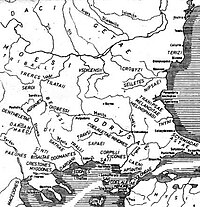Battle of Thermopylae (279 BC)
| Battle of Thermopylae | |||||||
|---|---|---|---|---|---|---|---|
| Part of Gallic invasion of the Balkans | |||||||
 Route of the Gallic invasion of the Balkans | |||||||
| |||||||
| Belligerents | |||||||
| Gauls |
Aetolians Boeotians Athenians Phocians | ||||||
| Commanders and leaders | |||||||
| Brennus | |||||||
The Battle of Thermopylae was fought in 279 BC between invading Gallic tribes and a combined army of Greek Aetolians, Boeotians, Athenians, Phocians at Thermopylae. The Gauls under Brennus were victorious, and advanced further into the Greek peninsula where they sacked Delphi.
Background
Gallic groups, originating from the various La Tène chiefdoms, began a south-eastern movement into the Balkan peninsula from the 4th century BC. Although Gallic settlements were concentrated in the western half of the Carpathian basin, there were notable incursions, and settlements, within the Balkan peninsula itself.
From their new bases in northern Illyria and Pannonia, the Gallic invasions climaxed in the early 3rd century BC, with the invasion of Greece. The 279 BC invasion of Greece proper was preceded by a series of other military campaigns waged toward southern Balkans and against the kingdom of Macedonia, favoured by the state of confusion ensuing from the intricated succession to Alexander.
The Celtic military pressure toward Greece in the southern Balkans reached its turning point in 281 BC. In 280 BC a great army, comprising about 85,000 warriors,[1] coming from Pannonia and split into three divisions, marched South in a great expedition[2][3] to Macedon and central Greece. Under the leadership of Cerethrius, 20,000 men moved against the Thracians and Triballi. Another division, led by Brennus[4] and Acichorius[5][6] moved against Paionians while a third division, headed by Bolgios, aimed for Macedonians and Illyrians.[7]

Bolgios inflicted heavy losses on the Macedonians, whose young king, Ptolemy Keraunos, was captured and decapitated. However, Bolgios' contingent was repulsed by the Macedonian nobleman Sosthenes, and satisfied with the loot they had won, Bolgios' contingents turned back. Sosthenes, in turn, was attacked and defeated by Brennus and his division, who were then free to ravage the country.
After these expeditions returned home, Brennus urged and persuaded them to mount a third united expedition against central Greece, led by himself and Acichorius.[7]
Battle
A Greek coalition made up of Aetolians, Boeotians, Athenians, Phocians, and other Greeks north of Corinth took up quarters at the narrow pass of Thermopylae, on the east coast of central Greece. During the initial assault, Brennus' forces suffered heavy losses. Hence he decided to send a large force under Acichorius against Aetolia. The Aetolian detachment, as Brennus hoped, left Thermopylae to defend their homes. The Aetolians joined the defense en masse - the old and women joining the fight.[8] Realizing that the Gallic sword was dangerous only at close quarters, the Aetolians resorted to skirmishing tactics.[9] According to Pausanias, only half the number that had set out for Aetolia returned.[7]
Eventually Brennus found a way around the pass at Thermopylae but the Greeks escaped by sea.
Aftermath
Brennus pushed on to Delphi where he was defeated and forced to retreat, after which he died of wounds sustained in the battle. His army fell back to the river Spercheios where it was routed by the Thessalians and Malians. Some of the survivors of the Greek campaign, led by Comontoris (one of Brennus' generals) settled in Thrace, founding a short-lived city-state named Tyle.[10] Another group of Gauls, who split off from Brennus' army in 281, were transported over to Asia Minor by Nicomedes I to help him defeat his brother and secure the throne of Bithynia. They eventually settled in the region that came to be named after them as Galatia. They were defeated by Antiochus I, and as a result, they were confined to barren highlands in the center of Anatolia.[11]
Notes
- ^ Kruta, Venceslas. Les Celtes, histoire et dictionnaire (in French). p. 493.
- ^ Cunlife, Barry. The Ancient Celts. pp. 80–81.
- ^ The term is a calque of the parallel French Grande expédition, that indicates, in French scholarly usage, the 279 BC surge of military campaigns on Greece.
- ^ Brennus is said to have belonged to an otherwise unknown tribe called the Prausi. See: Strabo, Geography 4:1.13. Not to be confused with the Brennus of the previous century, who sacked Rome in 387 BC.
- ^ Some writers suppose that Brennus and Acichorius are the same persons, the former being only a title and the latter the real name. Schmidt, "De fontibus veterum auctorum in enarrandis expeditionibus a Gallis in Macedoniania susceptis," Berol. 1834
- ^ Smith, William (1867). "Acichorius". In Smith, William (ed.). Dictionary of Greek and Roman Biography and Mythology. Vol. 1. Boston, MA. p. 12.
{{cite book}}: CS1 maint: location missing publisher (link) - ^ a b c "Guide for Greece". Pausanias. Livius.org. Retrieved 2008-09-21.
- ^ "Guide of Greece,". Pausanias. Livius.org. Retrieved 2008-09-21.
- ^ "Justin Book XXIV". Justin. forumromanum.org. Retrieved 2008-09-21.
- ^ "Celtic Settlement in North-Western Thrace during the Late Fourth and Third Centuries BC" (PDF). Nikola Theodossiev. caorc.org. Retrieved 2008-09-21.
- ^ Cunliffe, Barry. The Ancient Celts. p. 83.
{{cite book}}: Cite has empty unknown parameter:|coauthors=(help)
